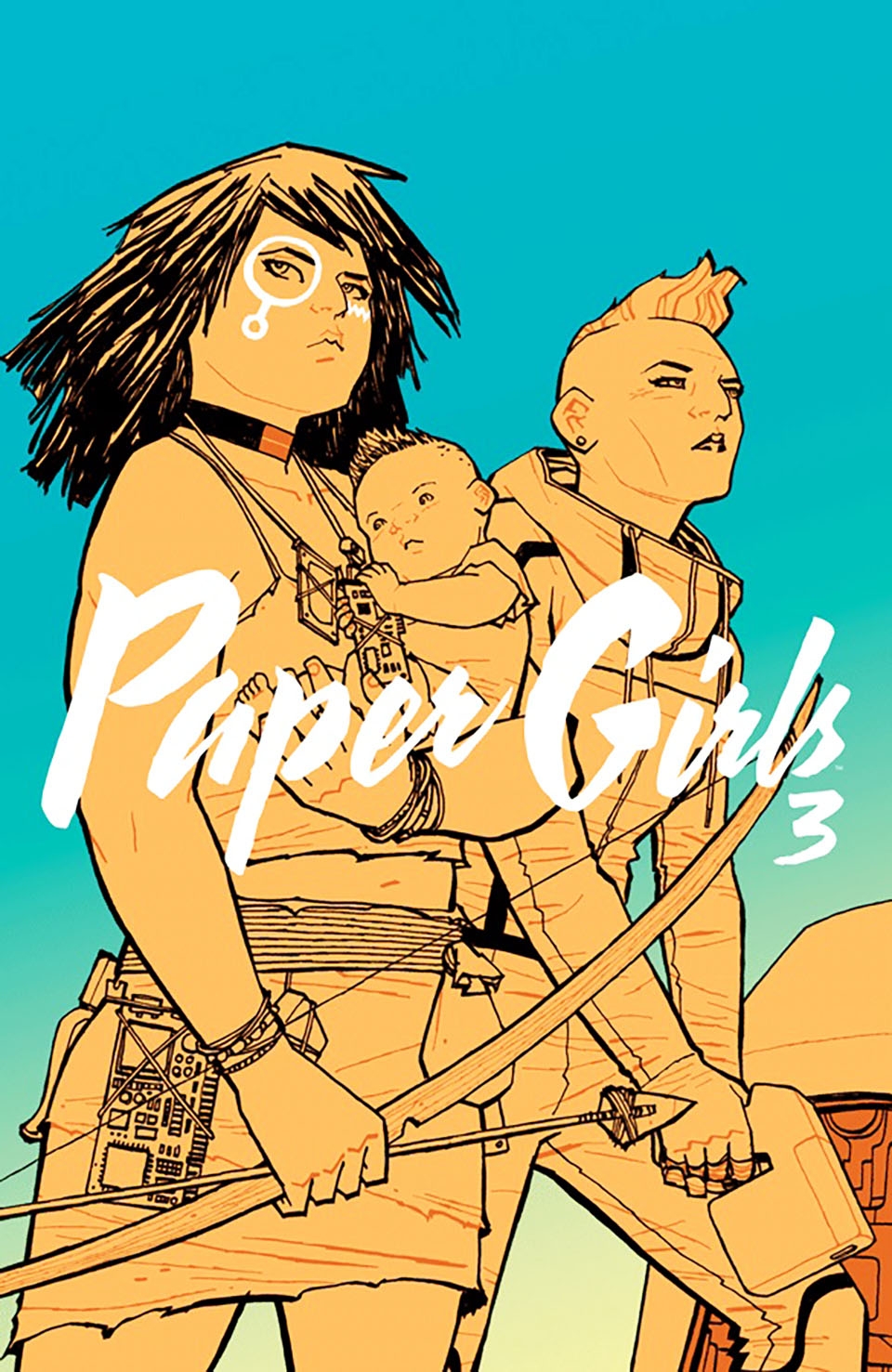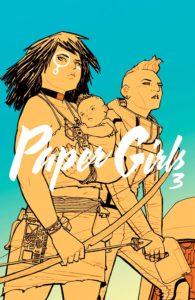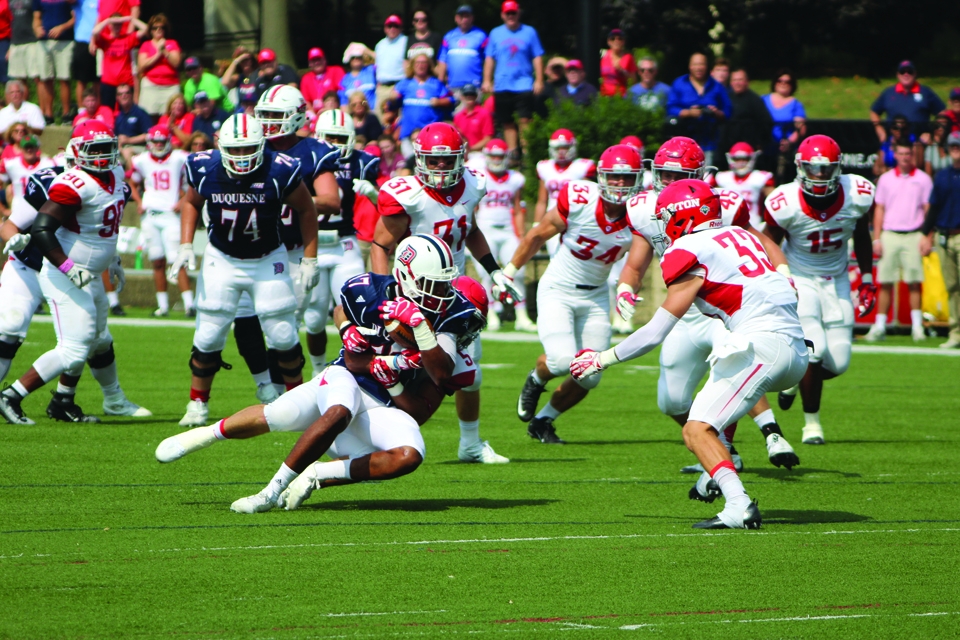

‘Paper Girls’ first published back in Oct. 2015. The series has earned two Eisener Awards for Best New Series and Best Penciller/Inker
By Nicole Prieto | Staff Writer
Paper Girls returned early August with its third trade paperback collecting Issues #11-15, following 12-year-old Erin and her fellow Stony Stream paper girls in their displacement to the far past. Faced against long-extinct megafauna and cavemen in high-tech gear, the girls find themselves in another temporal fight for their lives as they hunt for a way to escape 11,000 BCE. New readers for this underrated series be warned, as there are inevitable spoilers below.
Volume 2 left off with Erin, Tiff and Mac jumping off a helicopter into a time portal, transporting them from 2016 to thousands of years in the past. The three happily reunite with KJ, but find themselves at a loss in a dangerous world oddly riddled with signs of unintended interference from the far future. The third arch puts the focus on KJ after a five-issue absence, fleshing out her backstory and personality. The book opens with a dream sequence of KJ dealing with her anti-Semitic field hockey teammates and the presumed death of her grandmother — a Holocaust survivor.
Toward the middle of the volume, LGBT fans may appreciate an unexpected revelation about KJ that highlights the growing pains of first crushes and possible queer self-realization. From its earliest issue, writer Brian K. Vaughan has not sugarcoated the homophobic attitudes of the late ’80s, particularly through foul-mouthed Mac. In Volume 1, Mac is quick to judge a far-future teen lamenting the death of his boyfriend and loosely throws around what Erin politely refers to as, “the other F-word.” KJ’s accidental peek into the future, however, suggests that the comic may address how those attitudes play out as she may find herself coming out.
Even with its gimmicky premise of time-displaced preteens trying to get home to 1980s Ohio, Volume 3 hardly wastes time with light issues. The girls soon meet a no-nonsense archer-cavegirl named Wari trying to protect her infant son from his three violent fathers. (It takes a bit, but the sobering implications are not lost on the girls when Wari — herself hovering around their age — reveals the circumstances of her son’s conception.) Wari is doing all she can as a young mother surrounded by megafauna monsters while being plagued by incomprehensible dreams from the far future.
As in prior volumes, the Apple logo (as in, that Macintosh Apple) makes a ubiquitous appearance on far-future artifacts Erin and company encounter. It is a degree of single-target ad placement on par with the company adverts in Blade Runner. Even the mohawked-inventor-of-time-travel, Dr. Qanta Braunstein, hails from an Apple division apparently dedicated to bending the space-time continuum.
Amid the flurry of supernatural-scientific chaos, the comic still finds the breathing room to tackle old-fashioned, pubescent problems. When KJ suddenly gets her period in the middle of their adventure, she handles it calmly (and with an emergency handkerchief). Mac, on the hand, starts pelting her with questions and period myths gleaned from her older brother — displaying a noticeable dearth of health and sex education. The display is as amusing as it is discomfiting, given that sexual health ignorance is still a very modern issue.
The incident also gives more insight on Mac’s personality. It is no exaggeration to call her a pendulum of insecure contradictions. After KJ saves her from drowning in a river, the first thing Mac does is shove KJ off and call her a perv for giving her mouth-to-mouth. But the moment she notices the other girl bleeding the next morning, Mac’s immediate reaction is to blame herself for KJ getting hurt while rescuing her. In this respect, Vaughan is tactful about not spoon-feeding the audience on the girls’ complex and imperfect attributes. Mac can be irritatingly abrasive, but it is hard to doubt that she cares deeply for the others. KJ knows how to keep a cool head in emergencies, but that does not stop her from pulling off brave and dangerously impulsive stunts. She is 12 afterall.
Paper Girls is an adventure meant to level with teen audiences without patronizing them. The girls are young enough not to question the supernatural problems literally dropping on them out of thin air (at least, not for long). But they are definitely old enough to appreciate that they are in serious danger. For older folk, the comic is a sobering reminder of how adolescence is both an incredibly freeing and unbearably awkward experience. It steers clear of romanticizing the past. Vaughan does not ignore the less flattering social attitudes of kids growing up in the 1980s rust belt, for instance, nor does he ignore the frightening realities of being a 12-year-old surrounded by adults with questionable motives. He recognizes that the girls being kids does not magically exempt from them butting heads with adult problems.
Coupled with gorgeous artwork by Cliff Chiang — with colors and lettering by Matt Wilson and Jared K. Fletcher — the story is both a lively homage to 20th century pop culture and a blunt-force social commentary on coming of age. Issue #16 comes out Oct. 4. A hardback edition collecting Issues #1-10 releases on Nov. 1.


